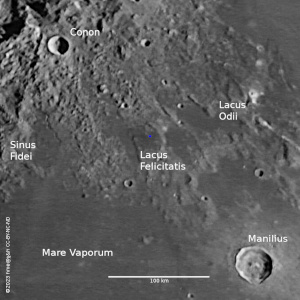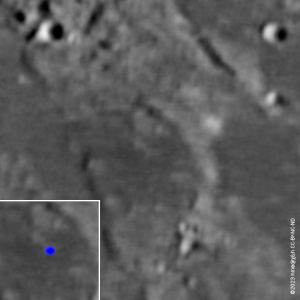
{
Practical astronomy
|
Astronomy
|
The Moon
|
The physical Moon
|
The Lunar 100
}
Lunar #99: Ina
I shall claim to have imaged this. I shall also claim that this is impossible to image. To disprove both these statements I invite you to look at a Lunar Picture of the Day from 2006 (Higgins and Wood 2006a), which shows the Ina depression as a small, but resolved feature. It looks like a regular, good quality image, but it is in fact spectacularly good. That image was taken with a telescope of 450 mm aperture.
Lacus Felicitatis lies on the southeastern slopes of the Montes Apenninus, halfway between craters Conon and Manilius. The "lake" is divided east to west into three planes with the middle one lying higher then the outer two. In this central, raised plain lies the Ina depression. It measures only 3 km and is only 30 m deep. 3 km translates to 1.6" or 6.8 pixels. That sounds fine, but the 200 mm aperture resolves only 0.7". Accordingly, my image shows a slightly elongated, bright patch in the right place to coincide with the sunlit northern and western wall of the depression.
These are Wood's notes (Hardwick 2013a):
Lying within Lacus Felicitatis, this little formation took some seeing. I found out that it only really appeared in moments of good seeing. Lying not far from crater Yangel, I could only see this caldera by inserting my 4 mm Uwan, which gave me x457, and letting it drift across my FOV. In those rare moments I could detect a D-shape formation, but could not make out if it was sunken or raised. I could also see a couple of really small craters or hills which were extremely close to Ina.
Images:
- The area imaged on 2023-02-28, stacked from 600 video frames taken with a Schmidt-Cassegrain reflector of D = 200 mm and f = 3500 mm and Canon EOS 600Dα camera. The phase was +64%.
- Dto. with annotation, scale, and the depression marked in blue.
- Dto., scaled up fourfold.



